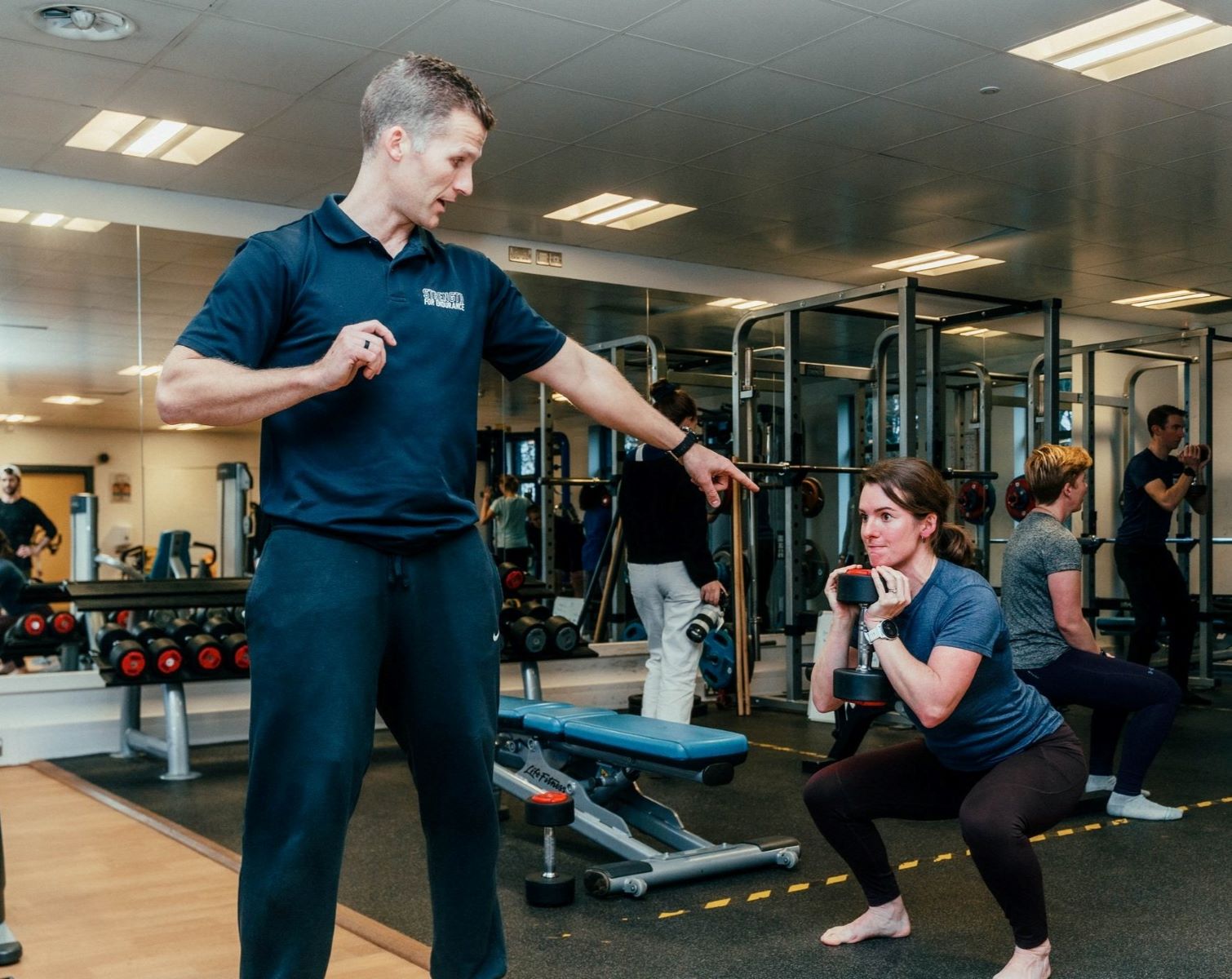Home>Misc>Featured>What Heart Rate Zone Should You Run A Marathon In


Featured
What Heart Rate Zone Should You Run A Marathon In
Modified: January 22, 2024
Discover the optimal heart rate zone for running a marathon in this informative guide. Maximize your endurance and performance with featured tips from experts.
Introduction
Running a marathon is a monumental challenge that requires both physical endurance and strategic planning. To ensure that you perform at your best and achieve your desired results, it is crucial to understand the concept of heart rate zones and how they impact marathon training and performance.
Heart rate zones are a tool used by athletes and trainers to measure and monitor the intensity of their workouts. These zones help runners optimize their training by ensuring they are exerting the right amount of effort for their specific goals, whether it’s building endurance, increasing speed, or balancing recovery and intensity.
By training within specific heart rate zones, marathon runners can target their training to meet the demands of the race. This approach allows for efficient and effective training sessions, minimizes the risk of overtraining or injury, and maximizes performance on race day.
In this article, we will explore the importance of heart rate zones in marathon running, how to determine your maximum heart rate, and how to calculate your target heart rate zones. We will also discuss each heart rate zone and its associated training benefits. Finally, we will delve into monitoring heart rate during a marathon and making adjustments to heart rate zones for race day.
Whether you are a seasoned marathoner or a beginner preparing for your first race, understanding and utilizing heart rate zones can help you optimize your training and improve your race performance. So, let’s dive in and unlock the power of heart rate training for marathons.
Understanding Heart Rate Zones
Before we delve into the practical application of heart rate zones in marathon running, it is important to understand what they are and how they are determined. Heart rate zones are different ranges of heartbeats per minute (BPM) that correspond to different levels of exercise intensity. These zones are typically divided into five zones, each representing a specific training goal and physiological response.
The five heart rate zones are based on a percentage of your maximum heart rate (MHR), which is the highest number of beats your heart can achieve in one minute. Your MHR is unique to you and can be calculated using a simple formula: subtract your age from 220. However, it’s worth noting that this formula provides a rough estimate and individual variations may exist.
Once you have determined your MHR, you can then establish your heart rate zones by assigning a percentage of your MHR to each zone. The intensity of each zone increases as you move from Zone 1 (the easiest) to Zone 5 (the most intense).
Understanding and training within these heart rate zones can provide several benefits. First, it can help you gauge and optimize the intensity of your workouts based on your individual fitness and training goals. It allows you to find the right balance between easy, moderate, and hard efforts, ensuring that you are neither undertraining nor overexerting yourself.
Second, training within specific heart rate zones helps to maximize the physiological adaptations necessary for marathon running. Each zone targets different energy systems and muscle fibers, contributing to improvements in aerobic capacity, endurance, lactate threshold, and overall performance.
Third, heart rate zones provide a useful tool for tracking progress and setting realistic training targets. By monitoring your heart rate during workouts and seeing how it responds to different intensities, you can assess improvements in fitness, adjust training plans accordingly, and set new goals.
Now that we have a basic understanding of heart rate zones and their benefits, let’s take a closer look at the specific importance and applications of these zones in marathon running.
Importance of Heart Rate Zones in Marathon Running
Heart rate zones play a crucial role in marathon training as they allow runners to optimize their training efforts and achieve their best possible performance on race day. Let’s explore some key reasons why understanding and training within heart rate zones is important in the context of marathon running.
First and foremost, heart rate zones provide a structured approach to training that ensures runners are targeting the right intensity for their specific goals. Long slow distance runs in Zone 1 help to build a strong aerobic base and improve endurance, while runs in Zones 3 and 4 push the lactate threshold and improve the body’s ability to sustain marathon pace.
Training in specific heart rate zones helps to stimulate the body’s physiological adaptations that are necessary for marathon performance. For example, training in Zones 2 and 3 encourages the development of capillaries and increases the number of mitochondria in the muscles, which enhances the body’s ability to efficiently use oxygen and fuel during long-distance runs. Additionally, training in Zone 4 helps to increase the body’s lactate threshold, allowing runners to maintain a faster pace for longer durations.
Heart rate zones also provide valuable feedback and allow runners to monitor their progress throughout their training journey. As runners gain fitness and become more efficient, they will notice improvements in their heart rate response during workouts. A decrease in heart rate at a given pace or effort level indicates an increase in fitness, while an unchanged or elevated heart rate may indicate fatigue or overtraining.
By utilizing heart rate zones, runners can also avoid the common mistake of training too hard too often. Marathon training requires a balance between high-intensity runs and recovery days. Training in the appropriate heart rate zone ensures that runners exert the right amount of effort in each workout, minimizing the risk of injury, burnout, and overtraining.
Furthermore, training within specific heart rate zones helps runners develop a better sense of pace and effort. Marathon running requires smart pacing strategies to avoid hitting the proverbial wall. By training in different zones, runners become more attuned to their body’s signals and can maintain a sustainable pace throughout the race.
In summary, heart rate zones are essential for marathon runners as they provide a structured approach to training, stimulate physiological adaptations, monitor progress, prevent overtraining, and improve pacing strategies. By understanding and training within these zones, runners can optimize their marathon training and set themselves up for success on race day.
Determining Your Maximum Heart Rate
One of the first steps in effectively utilizing heart rate zones for marathon training is determining your maximum heart rate (MHR). Your MHR is the highest number of beats your heart can achieve in one minute, and it serves as the foundation for establishing your heart rate zones. While there are various methods for determining MHR, the most common and widely accepted formula is subtracting your age from 220.
For example, if you are 30 years old, your estimated MHR would be 220 – 30 = 190 beats per minute (BPM). It is important to note that this is a crude calculation and individual variations exist. Factors such as genetics, fitness level, medications, and stress can influence your actual MHR.
While the 220 minus age formula is a good starting point, a more accurate approach is to perform a maximum effort exercise test under the supervision of a medical professional or trained exercise physiologist. This test typically involves running on a treadmill or cycling on an ergometer while wearing a heart rate monitor. During the test, your heart rate is gradually increased until you reach your maximum effort, allowing for the precise measurement of your MHR.
An alternative method is the “talk test.” This simple test involves running or exercising at a pace where you can still carry on a conversation comfortably. Once you reach a point where talking becomes challenging, your heart rate is likely in the vicinity of your lactate threshold, which is approximately 85-90% of your MHR. While this method is not as accurate as a maximum effort test, it can provide a useful estimate of your MHR.
Once you have determined your maximum heart rate, you can use it to establish your heart rate zones as a percentage of your MHR. For marathon training, the most commonly used heart rate zones are based on the percentage ranges below:
- Zone 1: 60-70% of MHR (Easy long runs and recovery runs)
- Zone 2: 70-80% of MHR (Base building and aerobic development)
- Zone 3: 80-90% of MHR (Tempo runs and marathon pace)
- Zone 4: 90-100% of MHR (Threshold runs)
- Zone 5: Maximum effort (Speed and interval training)
By determining your maximum heart rate and understanding the corresponding heart rate zones, you can effectively tailor your training to meet the specific demands of marathon running. This knowledge will allow you to train at the appropriate intensity levels, optimize your workouts, and achieve your desired performance outcomes.
Calculating Your Target Heart Rate Zones
Now that you have determined your maximum heart rate (MHR), you can calculate your target heart rate zones. These zones are based on a percentage range of your MHR and serve as a guide for training at specific intensities. Let’s explore how to calculate your target heart rate zones for marathon training.
Using the percentages recommended for marathon training, we can establish the following heart rate zones:
- Zone 1: 60-70% of MHR
- Zone 2: 70-80% of MHR
- Zone 3: 80-90% of MHR
- Zone 4: 90-100% of MHR
- Zone 5: Maximum effort
To calculate your target heart rate for each zone, you simply multiply the lower and upper percentages by your MHR. For example, if your MHR is 190 BPM:
- Zone 1: 60-70% of 190 BPM = 114-133 BPM
- Zone 2: 70-80% of 190 BPM = 133-152 BPM
- Zone 3: 80-90% of 190 BPM = 152-171 BPM
- Zone 4: 90-100% of 190 BPM = 171-190 BPM
Keep in mind that these calculations are estimates and individual variations can occur. Factors like fitness level, genetics, and current health conditions can influence your heart rate response. It’s important to listen to your body and make adjustments accordingly.
To ensure accuracy and consistency, it is highly recommended to use a heart rate monitor during your training sessions. A heart rate monitor will provide real-time feedback and allow you to stay within your desired heart rate zones throughout your workouts.
It’s worth mentioning that heart rate zones are not set in stone and can evolve as your fitness level improves. As you become fitter and your MHR changes, you may need to recalculate your heart rate zones periodically to ensure you are training at the appropriate intensities.
Now that you have calculated your target heart rate zones, you have a clear understanding of the intensity levels you should aim for in each training session. These heart rate zones will help you optimize your workouts, improve your endurance, and prepare you for the demands of marathon running.
Heart Rate Zone 1: Easy Long Runs
Heart rate Zone 1 is typically the lowest intensity zone and is often referred to as the “recovery zone” or “easy zone.” In this zone, you are working at 60-70% of your maximum heart rate (MHR). It is important to have a solid foundation in Zone 1 as it forms the basis for building endurance and improving aerobic capacity, both crucial for marathon running.
Easy long runs in Zone 1 are a key component of marathon training. These runs are typically longer in duration, allowing your body to adapt and build the necessary stamina to complete the 26.2-mile distance. When running in Zone 1, you should be able to maintain a conversational pace—able to speak comfortably without feeling out of breath.
Training in Zone 1 has several benefits for marathon runners. Firstly, it enhances aerobic endurance by improving the efficiency of oxygen delivery and utilization in the muscles. This helps strengthen the heart and cardiovascular system, enabling you to sustain a steady effort for a longer period of time.
In addition, Zone 1 runs facilitate the development of slow-twitch muscle fibers, which are essential for long-distance running. These muscle fibers are more resistant to fatigue and play a significant role in fuel utilization, allowing you to conserve glycogen and rely on fat as an energy source during prolonged efforts.
Furthermore, Zone 1 runs provide an opportunity for mental relaxation and stress relief. These slower, easier runs help reduce the physical and mental demands of higher-intensity workouts, allowing your body to recover and recharge. Running in Zone 1 can also serve as active recovery after more challenging training sessions, aiding in muscle repair and reducing the risk of overuse injuries.
Easy long runs in Zone 1 should be a consistent part of your marathon training plan. By dedicating time to running at a lower intensity, you will build endurance, strengthen your cardiovascular system, and lay a solid foundation for the more demanding workouts to come.
Heart Rate Zone 2: Base Building and Aerobic Development
Heart rate Zone 2 is commonly referred to as the “aerobic zone” or “base zone.” It encompasses an intensity range of 70-80% of your maximum heart rate (MHR). Training in this zone is essential for building a strong aerobic foundation, improving endurance, and preparing your body for the demands of marathon running.
Zone 2 runs should be performed at a comfortably challenging pace, where you can still carry on a conversation but may need to pause for breath occasionally. These runs are typically longer than Zone 1 runs and focus on steadily increasing your cardiovascular fitness and aerobic capacity.
Base building in Zone 2 has numerous benefits for marathon runners. Firstly, training in this zone further develops your aerobic system by increasing the efficiency of oxygen uptake and utilization. This results in an improved ability to deliver oxygen to the working muscles, delaying the onset of fatigue and improving overall endurance.
Zone 2 runs also help build muscular strength and endurance. As you continue to train in this zone, your slow-twitch muscle fibers adapt and become more efficient at utilizing oxygen and metabolizing fuel sources. This leads to greater mitochondrial density, improved capillary networks, and increased energy production, all of which contribute to enhanced endurance performance during long-distance running.
Moreover, Zone 2 runs provide mental benefits as well. The longer duration and moderate intensity of these runs help train your mind to stay focused and mentally strong during extended periods of effort. They also provide an opportunity for mindful running, allowing you to tune in to your body’s sensations and establish a strong mind-body connection.
As you progress in your marathon training, Zone 2 runs form the backbone of your workouts. These runs can be incorporated into your training plan as long steady-state runs, progression runs, or even hill workouts. The focus should be on maintaining an aerobic effort and gradually increasing the duration and distance covered.
By dedicating time to base building in Zone 2, you will experience substantial improvements in your aerobic fitness, endurance, and overall running performance. These workouts will prepare you for the higher-intensity efforts and more race-specific training that lie ahead.
Heart Rate Zone 3: Tempo Runs and Marathon Pace
Heart rate Zone 3, also known as the “threshold zone,” is the next level up in intensity. It encompasses a heart rate range of 80-90% of your maximum heart rate (MHR). Training in this zone is crucial for improving your lactate threshold, running economy, and race-specific fitness.
Tempo runs and marathon pace runs are the key workouts performed in Zone 3. Tempo runs are sustained efforts at a comfortably hard pace, just below your threshold. The goal is to increase your lactate threshold, which is the point at which lactic acid begins to accumulate in the muscles. By training in Zone 3, you can raise your lactate threshold, allowing you to maintain a faster pace for a longer period of time before fatigue sets in.
Marathon pace runs, on the other hand, are specific to marathon training and involve running at your predicted marathon race pace. By incorporating regular marathon pace runs in Zone 3, you familiarize your body and mind with the intensity and effort required to sustain your goal pace throughout the entire marathon.
Training in Zone 3 provides several benefits for marathon runners. One of the main advantages is an improvement in running economy. As you train at this intensity, your body becomes more efficient at utilizing oxygen and conserving energy. This leads to better movement economy, reduced energy wastage, and overall improved efficiency of your running mechanics.
Zone 3 workouts also stimulate mitochondrial adaptations and enhance anaerobic capacity. The increased intensity of these runs elicits a greater demand for energy production and utilization. This, in turn, leads to an increase in mitochondrial density and the development of fast-twitch muscle fibers, allowing you to generate more power and maintain a faster pace for longer durations.
Moreover, Zone 3 runs help build mental toughness and race-specific confidence. Training at or slightly below your lactate threshold forces you to push beyond your comfort zone. This challenges your mental resilience and teaches you to sustain a strong effort even when fatigue sets in. Mastering these workouts can give you the psychological edge needed to stay focused and maintain your pace during the rigors of a marathon race.
It is important to note that while Zone 3 workouts are essential for marathon training, they should not comprise the majority of your training volume. They are more demanding on the body and require adequate recovery to avoid overtraining and injury. It is recommended to include one or two Zone 3 workouts per week, alternating with easier runs in Zone 1 and Zone 2 to maintain a balanced training plan.
By incorporating tempo runs and marathon pace runs in heart rate Zone 3, you will improve your lactate threshold, boost running economy, and develop the mental fortitude needed to excel in the marathon. These workouts are instrumental in preparing you for the race-specific demands and helping you achieve your performance goals.
Heart Rate Zone 4: Threshold Runs
Heart rate Zone 4, commonly known as the “threshold zone,” is the next level of intensity in marathon training. It corresponds to an effort range of 90-100% of your maximum heart rate (MHR). Threshold runs performed in this zone are an essential component of training for marathon runners looking to increase their running speed and improve their performance.
Threshold runs require running at a sustained effort just below your maximum sustainable pace. The goal is to run as fast as possible while still maintaining control and avoiding a significant increase in blood lactate levels. These runs typically last anywhere from 20 minutes to an hour and push your body to the edge of its comfort zone.
Training in Zone 4 offers several benefits for marathon runners. Firstly, it helps to raise your lactate threshold. By regularly performing threshold runs, you teach your body to clear lactic acid more efficiently, allowing you to sustain a faster pace for longer before fatigue overwhelms you. This is crucial in a marathon, as it enables you to maintain your desired race pace for a longer duration.
Threshold runs also improve your running economy and efficiency. By training at a higher intensity, your body becomes more adept at using oxygen, producing energy, and minimizing energy waste. As a result, your stride becomes more economical, allowing you to cover more ground with less effort, ultimately leading to improved race times.
In addition, Zone 4 workouts stimulate muscle fiber recruitment and enhance anaerobic capacity. Threshold runs challenge your body to utilize its fast-twitch muscle fibers, which are responsible for generating power and speed. Over time, this leads to increased strength and power output, allowing you to maintain a faster pace and respond better to surges in a race.
Furthermore, threshold runs improve your mental toughness and ability to cope with discomfort. The high-intensity nature of these runs forces you to confront and embrace the discomfort that comes with pushing beyond your limits. By regularly challenging yourself in Zone 4, you train your mind to stay focused and resilient during the toughest parts of a marathon race.
Incorporating threshold runs into your training schedule should be done with caution. Due to their higher intensity, these workouts place more stress on your musculoskeletal system and require adequate recovery. It is recommended to gradually introduce threshold runs into your training plan and ensure you have a balanced mix of lower-intensity runs and recovery days to maximize the benefits without risking injury or burnout.
By incorporating threshold runs in heart rate Zone 4, you will raise your lactate threshold, improve running economy, develop strength and power, and enhance mental toughness. These workouts will help you sustain a faster pace during a marathon and give you the competitive edge necessary to achieve your performance goals.
Heart Rate Zone 5: Speed and Interval Training
Heart rate Zone 5, often referred to as the “maximum effort zone,” is the highest intensity zone in marathon training. It encompasses efforts above 100% of your maximum heart rate (MHR) and is reserved for speed and interval training sessions. Training in this zone challenges your anaerobic system, develops running speed, and improves your ability to handle high-intensity efforts.
Speed and interval workouts in Zone 5 involve short bursts of intense running followed by periods of active recovery. These workouts typically consist of repetitions of a set distance, such as 400 meters or 800 meters, at a pace significantly faster than your race pace. The purpose of these sessions is to improve your running speed and power, increase your lung capacity, and enhance your body’s ability to tolerate lactic acid buildup.
Working in Zone 5 has several benefits for marathon runners. Firstly, it improves your anaerobic capacity, which refers to your ability to sustain high-intensity efforts without accumulating excessive fatigue. By regularly pushing yourself to your maximum effort level, you train your body to tolerate and clear lactic acid more efficiently, enhancing your overall performance in a marathon.
Zone 5 workouts also enhance your neuromuscular coordination. The explosive nature of speed and interval training activates and recruits fast-twitch muscle fibers, which are responsible for generating maximum power and speed. This type of training improves your body’s ability to generate force with each running stride, resulting in increased running efficiency and a faster race pace.
Moreover, speed and interval workouts help break up the monotony of longer, steady-state runs. These high-intensity sessions challenge you both physically and mentally, providing a sense of excitement and variety in your training routine. They serve as a change of pace and give you the opportunity to tap into your competitive spirit.
It’s important to note that Zone 5 workouts should be added gradually and sparingly to your training plan. Due to their high intensity, they place significant stress on your body and require ample recovery time. It is recommended to perform one or two speed and interval sessions per week, with proper rest days in between to allow for recovery and adaptation.
By incorporating speed and interval training in heart rate Zone 5, you will improve your anaerobic capacity, enhance neuromuscular coordination, and break through speed barriers. These workouts will sharpen your race-specific speed and give you the extra edge necessary to achieve your marathon goals.
Monitoring Heart Rate during a Marathon
Monitoring your heart rate during a marathon can provide valuable insights into your effort level, help you pace yourself effectively, and prevent the risk of overexertion or burnout. While heart rate monitoring during a race may not be as precise as during training, it can still serve as a useful tool for maintaining optimal performance. Let’s explore the benefits and considerations of monitoring your heart rate during a marathon.
First and foremost, monitoring your heart rate allows you to gauge your effort level and ensure that you are not pushing too hard or taking it too easy. By staying within your target heart rate zones, you can maintain a sustainable pace throughout the race and avoid early fatigue. It serves as a helpful guide to prevent going out too fast in the early miles, which can lead to a diminished performance in the later stages of the race.
Monitoring your heart rate can also help you adjust your race strategy and make necessary pacing decisions. If you notice that your heart rate is consistently higher than expected, it may be an indication that you are exerting more effort than planned. In this case, you may need to adjust your pace accordingly to prevent burnout. On the other hand, if your heart rate is lower than expected, it may suggest that you have more in the tank and can increase your effort level to push for a faster finish.
During a marathon, it’s important to recognize that external factors such as weather conditions, terrain variations, and race-day adrenaline can affect your heart rate response. Be aware that your heart rate may be slightly higher than usual due to elevated temperatures or humidity. Additionally, uphill sections may cause a temporary spike in heart rate, while downhill sections may result in lower readings. It’s crucial to consider these factors and make adjustments based on perceived effort along with heart rate data.
When monitoring your heart rate during a marathon, it’s advisable to use a heart rate monitor with a chest strap rather than relying solely on wrist-based readings from a smartwatch or fitness tracker. Chest strap monitors tend to provide more accurate and consistent heart rate data, especially during high-intensity activities and in situations where there may be interference from other devices or environmental factors.
Ultimately, the goal of monitoring heart rate during a marathon is to help you maintain a sustainable effort level, adjust your pacing strategy if needed, and optimize your performance throughout the race. It’s important to remember that heart rate is just one tool in your arsenal, and it should be considered alongside other indicators such as perceived effort, pace, and overall race strategy.
By monitoring your heart rate during a marathon, you can make informed decisions about your effort level and pacing, helping you achieve a well-executed race and cross the finish line with pride.
Adjusting Heart Rate Zones for Race Day
When it comes to race day, adjusting your heart rate zones to account for the unique demands of the marathon can help you optimize your performance and achieve your goals. While your training heart rate zones provide a solid framework, factors such as race distance, course profile, weather conditions, and personal fitness levels may necessitate adjustments. Let’s explore the considerations for adjusting your heart rate zones on race day.
Firstly, it’s important to recognize that the marathon itself is a high-intensity effort. Regardless of your fitness level, running at or near your maximum heart rate for the full duration of a marathon is not sustainable. Therefore, it may be necessary to slightly modify your target heart rate zones to ensure a successful and well-paced race.
One common approach is to shift the entire heart rate range down by a few percentage points. For example, if your Zone 3 is normally set at 80-90% of your maximum heart rate, you might adjust it to 75-85% to account for the sustained effort required in a marathon. This adjustment helps to prevent early fatigue and allows for consistent pacing throughout the race.
In addition to adjusting the heart rate ranges, it’s important to consider the course profile and variations in effort level that may occur. Uphill sections naturally bring your heart rate higher, so it may be necessary to allow for a slight increase in your heart rate during these segments while maintaining an overall sustainable effort. On the other hand, downhill sections may lead to a lower heart rate reading, as the effort required to maintain your pace is reduced. It’s crucial to balance perceived effort along with heart rate data to make necessary adjustments during these course variations.
Weather conditions also play a significant role in heart rate response during a marathon. Elevated temperatures and humidity can increase your heart rate and exertion level, even at the same pace. In hot and humid conditions, it’s important to listen to your body and be prepared to adjust your target heart rate zones accordingly. Your focus should be on maintaining a sustainable effort based on your perceived exertion rather than solely relying on heart rate readings.
Another aspect to consider is your personal fitness level and training adaptations. As you progress through your training cycle, you may notice improvements in your aerobic fitness and running economy, which may lead to a lower heart rate response at a given pace. Adjusting your target heart rate zones to reflect these improvements ensures that you are training and racing at the appropriate intensity level.
It’s important to note that adjusting heart rate zones for race day is not a one-size-fits-all approach. Every runner is unique, and individual differences in response to effort and environmental factors need to be considered. It’s advisable to experiment with adjustments during your training runs to determine what works best for you on race day.
By making necessary adjustments to your heart rate zones on race day, you can ensure that you are running at a sustainable effort level, effectively pacing yourself, and maximizing your performance in the marathon. Balancing heart rate data with perceived effort and external factors will help you achieve a strong and successful race.
Conclusion
Understanding heart rate zones and their role in marathon running is a valuable tool for optimizing your training and achieving your performance goals. By training within specific heart rate zones, you can target the appropriate intensity levels to build endurance, improve aerobic capacity, increase speed, and enhance overall race performance.
Heart rate zones serve as a guide for training at the right intensity. Zone 1 focuses on easy long runs and recovery, helping to build a strong aerobic base. Zone 2 emphasizes base building and aerobic development, further enhancing endurance. Zone 3 incorporates tempo runs and marathon pace runs, improving lactate threshold and race-specific fitness. Zone 4 is used for threshold runs, pushing the limits of your sustainable pace. Finally, Zone 5 is for speed and interval training, boosting anaerobic capacity and max speed.
Determining your maximum heart rate and calculating your target heart rate zones provide a personalized approach to training. These zones are not fixed and may require adjustment based on race day conditions, course profile, and personal fitness level. Additionally, monitoring your heart rate during a marathon can help you pace yourself effectively and make necessary adjustments throughout the race.
It’s important to remember that heart rate zones are just one tool in your training arsenal. They should be considered in conjunction with perceived effort, pace, and overall race strategy. Each runner is unique, and adjustments may be needed to cater to individual responses and goals.
Finally, remember that effective marathon training requires a balanced approach. Incorporate a mix of training intensities, rest and recovery, and listen to your body. Regularly evaluating and adjusting your heart rate zones as needed will help you continuously improve and reach your full potential as a marathon runner.
Embrace the power of heart rate training, tailor your workouts accordingly, and enjoy the journey towards marathon success.









